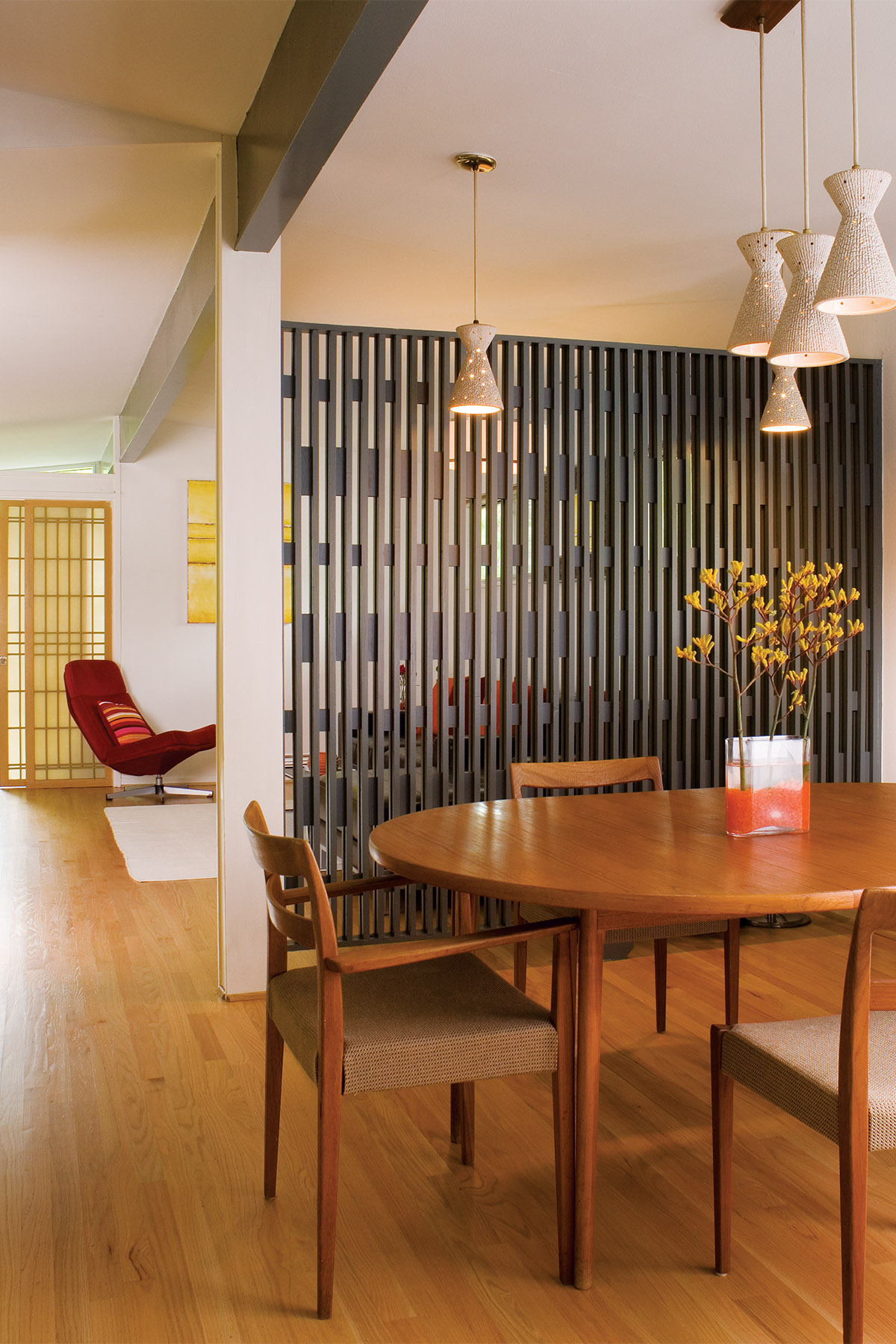It was 2006 when D Home first told you the story of Ju-Nel Homes, a Dallas architecture firm whose work in East and northeast Dallas was prevalent—and prominent—in the 1950s and ’60s. Founded by Jack Wilson and Lyle Rowley, both proteges of famed local modernist Howard Meyer, Ju-Nel specialized in building mid-century modern homes on sloped lots that were considered undesirable by their architectural ilk (and lenders, for that matter). Wilson and Rowley were passionate about preserving the natural landscape of a lot and were ahead of their time when it came to concepts like sustainability and energy efficiency. Their innovative work begot clients that were just as forward-thinking; advertising giant Stan Richards, modeling agency owner Kim Dawson, and philanthropist Hazael Beckett were all early Ju-Nel owners.
The pair split professionally in the mid ’60s, and in the years since they stopped practicing on their own—Rowley in 1967, and Wilson in 1981—their reputation dwindled to something of neighborhood lore. As was true for D Home writer Christine Rogers, many purchasers of Ju-Nels learned of their home’s architectural origins from neighbors, who often knew little more than the Ju-Nel name. [Full disclosure: Rogers is married to current D Magazine editor Tim Rogers.] Rogers’ 2006 article—and the White Rock Home Tour, which she spearheaded the same year—helped illuminate the work of these mid-century masters and identified 35 Ju-Nels that were known to still be in existence.
Now, a new website, ju-nel.com, takes Rogers’ work a step further in giving these visionary architects their due. For Mark Weeks, the man behind the domain, bringing the site to life has been a passion project 17 years in the making.
It began in 2007, when Weeks and his wife, Taylor, bought a 1965 house in Old Lake Highlands. He recalls the name Ju-Nel mentioned on a promotional flyer, though it didn’t mean anything to them at the time; the mid-century-modern enthusiasts just believed it to be a special house in need of some TLC. “It had been on the market for a while and needed a lot of work, which we were not nervous about,” he says. “We dove in headfirst.”
But when Weeks stumbled upon the D Home article, which listed his house among the 35, he was intrigued. He began looking into Ju-Nel’s body of work and talking with friends and neighbors about what they knew. “They would say, ‘Well you know, the rumor is that there’s like 50 of them,’” Weeks says. “So, I started thinking to myself, ‘How do you go find the 50?’”
For Weeks, the answer was simple: You hit the road. “I’d load our kids into the car on a Saturday, and I’d pick a neighborhood, and I’d just start driving streets,” he says with a chuckle. A few hours at a time over the course of 15 years, Weeks traversed every road in the areas known to have Ju-Nels—primarily East Dallas, Old Lake Highlands, and Lake Highlands—jotting down addresses of houses that bore the firm’s signature characteristics. He ended up with a list about 500 addresses long. “I didn’t really know what to do with it,” he says. “Along the way, I figured that the Dallas Buildings Department probably had some records.”
In what spare time he had between working a full-time job, rehabbing their house, and being a husband and father, Weeks spent hours—he figures it was around 1,000—hunting for permits obtained by Ju-Nel as an entity, or by Rowley or Wilson individually. He pored over microfiche files in the Dallas Building Department’s office as well as building-department ledgers at the J. Erik Jonsson Central Library, cross-referencing his list with official documentation. “They bring [the ledgers out] on a rolling cart, they’re so big,” Weeks says, describing the arduous task. “They’re probably 20- or 24-inches square by about three-inches thick, 40 lines on each page, and they’re all hand-written in script.”
Weeks also uncovered archived pages from a now-defunct website once dedicated to Ju-Nel homes, which held even more clues. After compiling Rogers’ list with those from the Dallas Historical Society and the online archives, there was a total of 99 homes identified in the public domain as having been built by Ju-Nel. Through his own research, he authenticated an additional 48, bringing the grand total to 147. He collected historical and MLS photos, deeds, and data for each one.

The final hurdle was getting his wealth of information out to the public. A veteran of the retail industry who now works in real estate, Weeks had zilch by way of web-development experience. Undeterred, he purchased the ju-nel.com domain and learned on the fly, building his site from the proverbial ground up in six months.
The result is an authoritative source for all things Ju-Nel. Officially launched on March 5, the site includes an interactive map cataloging the 99 “known” homes, with the 48 “rediscovered” homes to be unveiled over time. It details the signature characteristics of a Ju-Nel home and reveals more about Rowley and Wilson, as well as their wives, Julie and Nelda, respectively, who inspired the firm’s name. It also features a collection of quintessential works that Weeks has designated “Super Ju-Nels”—homes of particular architectural significance that have been well preserved, inside and out.
That preservation piece, especially, is what drove Weeks to devote the past 17 years of his life to this project. Six Ju-Nels have been already demolished to make way for more sizable structures, and many more have been remodeled beyond recognition. By bringing attention to Wilson, Rowley, and their legacy, Weeks has taken up the mantle of historian in hopes of saving others from similar fates. “We don’t do a great job of A., documenting and B., preserving works from mid-century architects,” Weeks says. “I hope that people walk away from the site with an appreciation of the skill and talent of Jack and Lyle and with a broader awareness of mid-century modern houses.”
Weeks comes from a long line of architects, architectural appreciators, and preservationists. His great-grandfather was a civil engineer; his grandfather was an architect who studied under famed modernist Ludwig Mies van der Rohe; and his mother grew up in a Frank Lloyd Wright house. “That idea of modernism is really kind of baked into the DNA of who I am,” Weeks says. “This is my way of honoring my grandfather and great grandfather’s work.”
But his work isn’t over. To further chronicle the jewels of Ju-Nel, Weeks has reached out to his fellow “known” homeowners. So far, two dozen have eagerly invited him to tour and photograph the interiors, many of which have not been seen in decades. “They’re very excited to share their stories of their Ju-Nel with other owners and enthusiasts,” Weeks says.
He acknowledges that there are likely more Ju-Nels yet to be rediscovered; some 95 on his original list were unable to be traced, as the permits were either lost or misfiled by the City of Dallas. He hopes that the site will provide an avenue for owners to come forward with any information that would aid in authentication.
While Rogers explored the idea of pursuing historic designation in 2006, at the time, many of the homes didn’t meet the Texas Historical Commission’s 50-year age minimum. Now that they’re of the right vintage, Weeks and Rogers are once again exploring the possibility.
“The question is, how do we get people involved in a movement that starts to look at these homes as pieces of Dallas history? Because that’s really what they are,” Weeks says. “Preservation is paramount.”
Author







